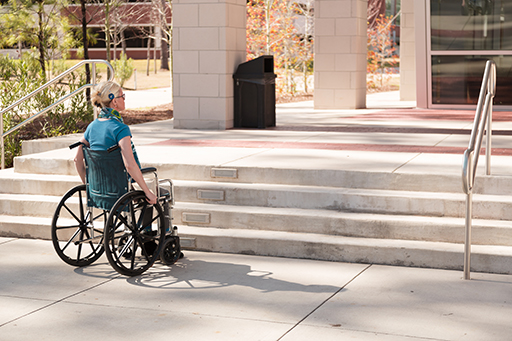2.3 Assessing the two models
Imagine approaching a building with the intention of entering, only to find that a set of stairs blocks your way. Where does the problem lie in this scenario? Is it the individual’s physical limitation, or is it the environment that fails to accommodate diverse needs?
This next activity encourages you to consider the two perspectives: the medical model and the social model. As a result, you’ll explore how framing the issue differently can influence attitudes, policies, and ultimately, inclusion.
Activity 2 Analysing a scenario
Consider the scenario in Figure 2. According to the two models you’ve learned about, where does the problem lie?
Discussion
The medical model would suggest this is a personal challenge one must overcome at the individual level with the help of medical specialists. The model says the problem is the person that needs a wheelchair. This example can lay the foundation for discrimination.
The social model would suggest that addressing the external barriers a person experiences is crucial for fostering an inclusive society. The model says that the problem is the lack of consideration in the design of the building.
Having considered the two models, reflect now on the kinds of environment these models could foster, and consider the following questions.
In many environments, accessibility remains a significant challenge for individuals who use wheelchairs. Buildings that lack proper accommodations, such as ramps or elevators, can severely limit mobility and independence. This not only affects physical access but also has profound implications for a person’s wellbeing and self-worth.
How might a person’s wellbeing and self-worth be impacted?
How might an educator’s or employer’s awareness of the social model of disability reshape their strategies for supporting those with dyslexia?
Watch this ten-minute short film called ‘Enitan’:
Video 1: Enitan (open the link in a new tab/window so you can return here easily)
However, barriers are not just physical. Next you will start to look at invisible disabilities.

